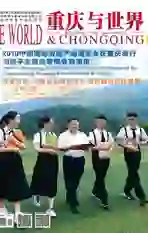重庆大韩民国临时政府旧址
2019-09-10
年代:始建于民国
Time of Construction: Built during the Period of the Republic of China (1912-1949)
坐标:渝中区莲花池正街38号 No.38, Lianhuachi Main Street, Yuzhong District
重庆,是大韩民国临时政府在中国的最后一个办公地。1944年至1945年,大韩民国临时政府租用渝中区莲花池行馆集中办公。1992年中韩建交,经两国政府协商,莲花池38号作为中韩人民并肩作战,共同抗日的历史见证。在不少韩国人看来,大韩民国临时政府旧址也是“韩国独立运动旧址”。
大韩民国临时政府旧址占地约1300平方米,建筑面积约1770平方米,是一处由5幢小楼房组成的建筑群,青瓦灰砖,两排建筑顺着中间的石梯往上延伸。大门的门楣上用韩文、繁体中文和英文分别写着“大韩民国临时政府”字样。
跨进大门,左边是1号楼,原为庶务局、警卫队、文化部、军务部、宣传部办公室,如今被辟为展览厅。右边为2号楼,分上下两层,一楼是临时议政院会议室兼临时政府食堂。二楼是外务部,外务部部长、次长办公室。3号楼3楼则是大韩民国临时政府主席金九的办公室和国务委员会议室。
如今,这里是一座研究、展示朝鲜半岛独立运动史的专题型陈列馆。1992年8月,重庆大韩民国临时政府旧址被列为重庆市文物保护单位;1995年8月11日正式修复成纪念馆并对外开放;2000年对旧址再次进行了全面维修。
2019年3月1日,正值朝鲜半岛“三一运动”100周年纪念之际,陈列馆“大韩民国临时政府在重庆历史陈列”改陈竣工,最大程度地按原貌恢复了当年临时政府办公风貌。3月28日至30日,韩国总理李洛渊访问重庆,为重庆韩国光复军总司令部旧址复建完工暨对外开放仪式剪彩,并参观了大韩民国临时政府旧址。
大韩民国临时政府是朝鲜半岛被日本侵略、吞并后成立的一个临时政府,被称为“朝鲜半岛独立运动的圣殿”,是一个在中国坚持了长达27年的反日复国独立运动的流亡政府。
1910年8月,日本帝国主义将“庚戌国耻”强加给旧韩国政府,朝鲜半岛从此开始了反抗日本殖民统治,争取民族自由和独立的不屈不挠的斗争。
1919年3月1日,朝鲜半岛爆发了“三一运动”。“三一运动”失败后,韩国的民族独立运动领导人在苏联的海参崴、中国的上海,以及朝鲜半岛的汉城(今首尔),成立了类似政府的组织。同年9月,3个组织在上海法租界合并成“大韩民国临时政府”。
中国抗日战争全面爆发后,大韩民国临时政府在中国政府的帮助和支援下,从上海、杭州、长沙等地一路西迁,于1939年抵达重庆,1940年到达重庆市区,先后在石板街、杨柳街、吴师爷巷办公。最后,由国民政府出面并出资安置于重庆市莲花池38号,大韩民国临时政府和独立运动的领导人金九等办公并居住于此。1945年8月,日本戰败投降,大韩民国临时政府主要官员分批回国。在重庆的6年是大韩民国临时政府在中国开展民族独立运动最重要、最活跃的时期。
From 1944 to 1945, the Provisional Government of the Republic of Korea rented a place in Lianhuachi of Yuzhong district as an official residence. In 1992, China and the Republic of Korea established diplomatic relations. Upon consultations between the two governments, the location of No. 38 of Lianhuachi is chosen to be a historical testimony witnessing the history of two nation’s standing together in the fight against Japanese invaders. As Chongqing is known to be the last place for the office of the Provisional Government of the Republic of Korea in China, the site of the Provisional Government of the Republic of Korea is correspondingly seen as the “home of the Korean independence movement” as well by many Koreans.
With a construction area of about 1,770 square meters, the site of the Provisional Government of the Republic of Korea covers a ground area of about 1,300 square meters. It is a group of five small buildings with blue tiles and grey bricks, which line in two rows and extend upwards along a stone ladder in the middle. On the threshold of the gate writes the words “THE PROVISIONAL GOVERNMENT OF THE REPUBLIC OF KOREA” respectively in Korean, traditional Chinese and English.
Stepping into the gate, you will see Building 1 on the left. Originally composed of the Bureau of General Affairs, the Guard, the Ministry of Culture, the Ministry of Military Affairs, and the Office of the Publicity Department, the building is now developed into an exhibition hall. Building 2 is on the right, which is divided into two floors. The first floor is the office of temporary council room plus the temporary government canteen. The second floor covers the Ministry of Foreign Affairs, the Office of the Minister of Foreign Affairs and the Office of the Vice Minister while the Office of the Premier of the Provisional Government of Republic of Korea Kim Gu and the Meeting Room for the State Council are on the third floor of Building 3.
Today, the site has been upgraded into a thematic exhibition hall which provides with studies and displays of the history of the independence movement of the Korean Peninsula. In August 1992, the Site of the Provisional Government of the Republic of Korea of Chongqing was listed as the cultural relic protection unit of Chongqing; on August 11, 1995, it was officially restored into a memorial hall and opened to the public. In 2000, an overall refurbishment was conducted upon the site again.
On the occasion of the 100th anniversary of the “March 1st Movement” on the Korean Peninsula on March 1, 2019, the basic exhibition of the exhibition hall, called “Historical Exhibition of the Provisional Government of the Republic of Korea in Chongqing”, completed its adjustment so as to restore and present the original landscape of the then provisional government to the fullest extent. From March 28th to 30th, prime minister of South Korea Lee Nak-yeon visited Chongqing to participate in the ribbon-cutting ceremony for the completion of the re-construction and opening of the Site of the Korean Liberation Army General Command in Chongqing. He also toured the Site of Provisional Government of the Republic of Korea.
Being called as the “Sanctuary of Independence Movement of the Korean Peninsula”, the Provisional Government of the Republic of Korea is an interim government established after the Korean Peninsula was invaded and annexed by Japan. In this sense, it is an anti-Japanese government-in-exile that has persisted for as long as 27 years in China in order to regain independence.
Due to the Japan–Korea Treaty signed in August, 1910, Korean government was forced to bear the pain of “National humiliation of the year of Gyeongsul” imposed by Japanese imperialism. The Korean government in exile was thus established to fight against Japanese colonial rule of Korea and strive for national independence on the Korean Peninsula.
On March 1, 1919, the “March 1st Movement” broke out on the Korean Peninsula. After the failure of the Movement, leaders of the Korean National Independence Movement established several organizations similar to government in Vladivostok (the Soviet Union), Shanghai (China), and Hansung (now Seoul) on the Korean Peninsula. In September of the same year, three organizations merged into the “Provisional Government of the Republic of Korea” in the French Concession of Shanghai.
After the outbreak of the Chinese People’s War Against Japan War, the Provisional Government of the Republic of Korea migrated westward from Shanghai, Hangzhou, Changsha and other places with the help and support of the Chinese government. Finally arriving in Chongqing in 1939 and settling down in the downtown of Chongqing a year later, the Provisional Government held its office successively at Shiban Street, Yangliu Street and Wushiye Lane. At last, it was the National Government that raised a fund and settled the place for the Provisional Government at No. 38, Lianhuachi in Chongqing. Since then, this place has become the official location for the Provisional Government of the Republic of Korea and leaders of the independence movement like Kim Gu to work and live in. It was not until Japan’s defeat and surrender in August 1945 that the main officials of the Provisional Government of the Republic of Korea returned to their motherland in succession. The six years in Chongqing is the most important and active period for the Provisional Government of the Republic of Korea to carry out the national independence movement in China.
